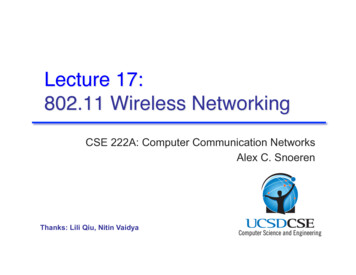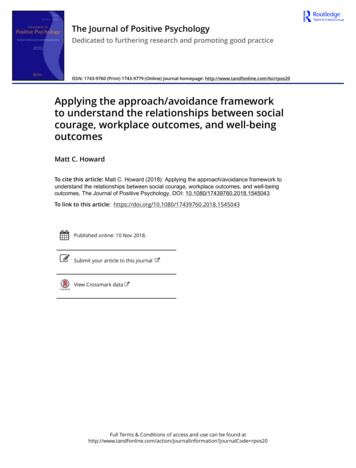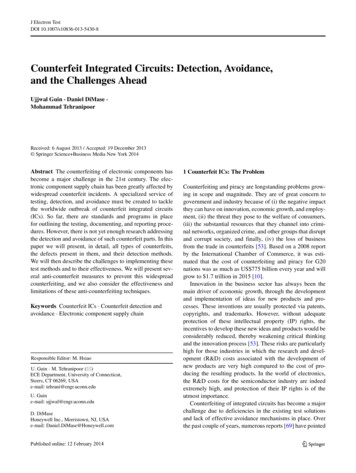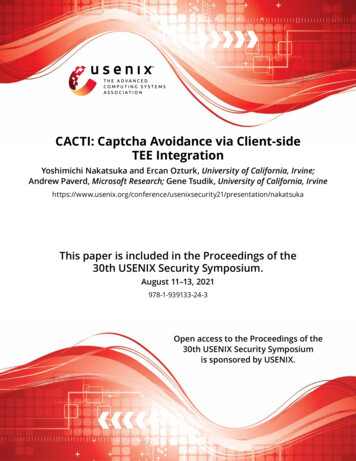
Transcription
CACTI: Captcha Avoidance via Client-sideTEE IntegrationYoshimichi Nakatsuka and Ercan Ozturk, University of California, Irvine;Andrew Paverd, Microsoft Research; Gene Tsudik, University of California, rity21/presentation/nakatsukaThis paper is included in the Proceedings of the30th USENIX Security Symposium.August 11–13, 2021978-1-939133-24-3Open access to the Proceedings of the30th USENIX Security Symposiumis sponsored by USENIX.
CACTI: Captcha Avoidance via Client-side TEE IntegrationYoshimichi Nakatsuka Ercan Ozturk Andrew Paverd†Gene TsudikUC IrvineUC IrvineMicrosoft ResearchUC microsoft.comgene.tsudik@uci.eduAbstractPreventing abuse of web services by bots is an increasinglyimportant problem, as abusive activities grow in both volume and variety. CAPTCHAs are the most common way forthwarting bot activities. However, they are often ineffectiveagainst bots and frustrating for humans. In addition, somerecent CAPTCHA techniques diminish user privacy. Meanwhile, client-side Trusted Execution Environments (TEEs) arebecoming increasingly widespread (notably, ARM TrustZoneand Intel SGX), allowing establishment of trust in a small part(trust anchor or TCB) of client-side hardware. This promptsthe question: can a TEE help reduce (or remove entirely) userburden of solving CAPTCHAs?In this paper, we design CACTI: CAPTCHA Avoidance viaClient-side TEE Integration. Using client-side TEEs, CACTIallows legitimate clients to generate unforgeable rate-proofsdemonstrating how frequently they have performed specificactions. These rate-proofs can be sent to web servers in lieuof solving CAPTCHAs. CACTI provides strong client privacy guarantees, since the information is only sent to thevisited website and authenticated using a group signaturescheme. Our evaluations show that overall latency of generating and verifying a CACTI rate-proof is less than 0.25 sec,while CACTI’s bandwidth overhead is over 98% lower thanthat of current CAPTCHA systems.1IntroductionIn the past two decades, as Web use became almost universaland abuse of Web services grew dramatically, there has beenan increasing trend (and real need) to use security tools thathelp prevent abuse by automated means, i.e., so-called bots.The most popular mechanism is CAPTCHAs: CompletelyAutomated Public Turing test to tell Computers and HumansApart [58]. A CAPTCHA is essentially a puzzle, such as an Thefirst and second authors contributed equally to this work.partially done while visiting the University of California, Irvine,as a US-UK Fulbright Cyber Security Scholar.† WorkUSENIX Associationobject classification task (Figure 1a) or distorted text recognition (see Figure 1b), that aims to confound (or at least slowdown) a bot, while being easily1 solvable by a human user.CAPTCHAs are often used to protect sensitive actions, suchas creating a new account or submitting a web form.Although primarily intended to distinguish humans frombots, it has been shown that CAPTCHAs are not very effective at this task [50]. Many CAPTCHAs can be solved byalgorithms (e.g., image recognition software) or outsourcedto human-driven CAPTCHA-farms2 to be solved on behalfof bots. Nevertheless, CAPTCHAs are still widely used toincrease the adversary’s costs (in terms of time and/or money)and reduce the rate at which bots can perform sensitive actions. For example, computer vision algorithms are computationally expensive, and outsourcing to CAPTCHA-farmscosts money and takes time.From the users’ perspective, CAPTCHAs are generallyunloved (if not outright hated), since they represent a barrierand an annoyance (a.k.a. Denial-of-Service) for legitimateusers. Another major issue is that most CAPTCHAs are visual in nature, requiring sufficient ambient light and screenresolution, as well as good eyesight. Much less popular audioCAPTCHAs are notoriously poor, and require a quiet setting,decent-quality audio output facilities, as well as good hearing.More recently, the reCAPTCHA approach has become popular. It aims to reduce user burden by having users click acheckbox (Figure 1c), while performing behavioral analysisof the user’s browser interactions. Acknowledging that eventhis creates friction for users, the latest version (“invisible reCAPTCHA”) does not require any user interaction. However,the reCAPTCHA approach is potentially detrimental to userprivacy because it requires maintaining long-term state, e.g.,in the form of Google-owned cookies. Cloudflare recentlydecided to move away from reCAPTCHA due to privacyconcerns and changes in Google’s business model [14].Notably, all current CAPTCHA-like techniques are server1 Exactlywhat it means to be “easily” solvable is subject to some debate.CAPTCHA farm is usually sweatshop-like operation, where employees solve CAPTCHAs for a living.2A30th USENIX Security Symposium2561
side, i.e., they do not rely on any security features of, or makeany trust assumptions about, the client platform. The purelyserver-side nature of CAPTCHAs was reasonable when clientside hardware security features were not widely available.However, this is rapidly changing with the increasing popularity of Trusted Execution Environments (TEEs) on a varietyof computing platforms, e.g., TPM and Intel SGX for desktops/laptops and ARM TrustZone for smartphones and evensmaller devices. Thus, it is now realistic to consider abuseprevention methods that include client-side components. Forexample, if a TEE has a trusted path to some form of user interface, such as a mouse, keyboard, or touchscreen, this trustedUser Interface (UI) could securely confirm user presence. Although this feature is still unavailable on most platforms, itis emerging through features like Android’s Protected Confirmation [33]. This approach’s main advantages are minimizeduser burden (e.g., just a mouse click) and increased security,since it would be impossible for software to forge this action.Admittedly however, this approach can be defeated by adversarial hardware e.g., a programmable USB peripheral thatpretends to be a mouse or keyboard.However, since the majority of consumer devices do not currently have a trusted UI, it would be highly desirable to reducethe need for CAPTCHAs using only existing TEE functionality. As discussed above, the main goal of modern CAPTCHAsis to increase adversarial costs and reduce the rate at whichthey can perform sensitive actions. Therefore, if legitimateusers had a way to prove that their rate of performing sensitiveactions is below some threshold, a website could decide toallow these users to proceed without solving a CAPTCHA. Ifa user can not provide such a proof, the website could simplyfall back to using CAPTCHAs. Though this would not fullyprevent bots, it would not give them any advantage comparedto the current arrangement of using CAPTCHAs.Motivated by the above discussion, this paper presentsCACTI, a flexible mechanism for allowing legitimate users toprove to websites that they are not acting in an abusive manner.By leveraging widespread and increasing availability of clientside TEEs, CACTI allows users to produce rate-proofs, whichcan be presented to websites in lieu of solving CAPTCHAs.A rate-proof is a simple assertion that:1. The rate at which a user has performed some action isbelow a certain threshold, and2. The user’s time-based counter for this action has beenincremented.When serving a webpage, the server selects a threshold valueand sends it to the client. If the client can produce a rate-prooffor the given threshold, the server allows the action to proceedwithout showing a CAPTCHA. Otherwise, the server presentsa CAPTCHA, as before. In essence, CACTI can be seen as atype of “express checkout” for legitimate users.One of the guiding principles and goals of CACTI is userprivacy – it reveals only the minimum amount of informationand sends this directly to the visited website. Another prin-256230th USENIX Security Symposiumciple is that the mechanism should not mandate any specificsecurity policy for websites. Websites can define their ownsecurity policies e.g., by specifying thresholds for rate-proofs.Finally, CACTI should be configurable to operate without anyuser interaction, in order to make it accessible to all users,including those with sight or hearing disabilities.Although chiefly motivated by the shortcomings ofCAPTCHAs, we believe that the general approach of clientside (TEE-based) rate-proofs, can also be used in other common web scenarios. For example, news websites could allowusers to read a limited number of articles for free per month,without relying on client side cookies (which can be cleared)or forcing users to log-in (which is detrimental to privacy). Online petition websites could check that users have not signedmultiple times, without requiring users to provide their emailaddresses, which is once again, detrimental to privacy. Wetherefore believe that our TEE-based rate-proof concept is aversatile and useful web security primitive.Anticipated contributions of this work are:1. We introduce the concept of a rate-proof, a versatile websecurity primitive that allows legitimate users to securelyprove that their rate of performing sensitive actions fallsbelow a server-defined threshold.2. We use the rate-proof as the basis for a concrete clientserver protocol that allows legitimate users to presentrate-proofs in lieu of solving CAPTCHAs.3. We provide a proof-of-concept implementation ofCACTI, over Intel SGX, realized as a Google Chromebrowser extension.4. We present a comprehensive evaluation of security, latency, and deployability of CACTI.Organization: Section 2 provides background information,and Section 3 defines our threat model and security requirements. Next, Section 4 presents our overall design and highlights the main challenges in realizing this. Then, Section 5explains our proof of concept implementation and discusseshow CACTI overcomes the design challenges, followed bySection 6 which presents our evaluation of the security, performance, and deployability of CACTI. Section 7 discussesfurther optimizations and deployment considerations, and Section 8 summarizes related work.22.1BackgroundTrusted Execution EnvironmentsA Trusted Execution Environment (TEE) is a primitive thatprotects confidentiality and integrity of security-sensitive codeand data from untrusted code. A typical TEE provides thefollowing features:Isolated execution. The principal function of a TEE is toprovide an execution environment that is isolated from allother software on the platform, including privileged systemsoftware, such as the OS, hypervisor, or BIOS. Specifically,USENIX Association
(a) Image-based object recognition reCAPTCHA [18](b) Image-based text recognition reCAPTCHA [18](c) Behavior-based reCAPTCHA [18]Figure 1: Examples of CAPTCHAsdata inside the TEE can only be accessed by the code running inside the TEE. The code inside the TEE provides welldefined entry points (e.g., call gates), which are enforced bythe TEE.Remote attestation. Remote attestation provides a remoteparty with strong assurances about the TEE and the code running therein. Specifically, the TEE (i.e., the prover) creates acryptographic assertion that: (1) demonstrates that it is a genuine TEE, and (2) unambiguously describes the code runningin the TEE. The remote party (i.e., the verifier) can use thisto decide whether to trust the TEE, and then to bootstrap asecure communication channel with the TEE.Data sealing. Data sealing allows the code running insidethe TEE to encrypt data such that it can be securely storedoutside the TEE. This is typically implemented by providingthe TEE with a symmetric sealing key, which can be used toencrypt/decrypt the data. In current TEEs, sealing keys areplatform-specific, meaning that data can only be unsealed onthe same platform on which it was sealed.Hardware monotonic counters. A well known attackagainst sealed data is rollback, where the attacker replacesUSENIX Associationthe sealed data with an older version.Mitigating this requiresat least some amount of rollback-protected storage, typicallyrealized as a hardware monotonic counter. When sealing,the counter can be incremented and the latest value is included in the sealed data. When unsealing, the TEE checksthat the included value matches the current hardware countervalue. Since hardware counters themselves require rollbackprotected storage, TEEs typically only have a small numberof counters.One prominent TEE example is Intel Software Guard Extensions (SGX) [24, 43, 48]. SGX is a hardware-enforced TEEavailable on Intel CPUs from the Skylake microarchitectureonwards. SGX allows applications to create isolated environments, called enclaves, running in the application’s virtual address space. A special region in physical memory is reservedfor enclaves, called the Enclave Page Cache (EPC). The EPCcan hold up to 128MB of code and data, shared between allrunning enclaves. When enclave data leaves the CPU boundary, it is transparently encrypted and integrity-protected byCPU’s Memory Encryption Engine (MEE) to defend againstphysical bus snooping/tampering attacks. Since enclaves runin the application’s virtual address space, enclave code canaccess all the memory of its host application, even that outsidethe enclave. Enclave code can only be called via predefinedfunction calls, called ECALLs.Every enclave has an enclave identity (MRENCLAVE), whichis a cryptographic hash of the code that has been loaded intothe enclave during initialization, and various other configuration details. Each enclave binary must be signed by thedeveloper, and the hash of the developer’s public key is storedas the enclave’s signer identity (MRSIGNER).SGX provides two types of attestation: local and remote.Local attestation allows two enclaves running on the sameplatform to confirm each other’s identity and communicate securely, even though this communication goes via the untrustedOS. SGX uses local attestation to build remote attestation.Specifically, an application enclave performs local attestationwith an Intel-provided quoting enclave, which holds a groupprivate key provisioned by Intel. The quoting enclave verifies the local attestation and creates a signed quote, whichincludes the application enclave’s and signer’s identities, aswell as user-defined data provided by the application enclave.This quote is sent to the remote verifier, which, in turn, usesthe Intel Attestation Service (IAS) to verify it. Since the attestation uses a group signature scheme, the verifier cannotdetermine whether two quotes were generated by the sameplatform.In SGX, data can be sealed in one of two modes, basedon: (1) the enclave’s identity, such that only the same type ofenclave can unseal it, or (2) the signer identity, such that anyenclave signed by the same developer (running on the sameplatform) can unseal it. SGX provides hardware monotoniccounters and allows each enclave to use up to 256 counters ata time.30th USENIX Security Symposium2563
2.2Group SignaturesA group signature scheme aims to prevent the verifier fromdetermining the group member which generated the signature.Each group member is assigned a group private key undera single group public key. In case a group member needs tobe revoked, a special entity called group manager can openthe signature. A group signature scheme is composed of fivealgorithms [26]: Setup: Given a security parameter, an efficient algorithmoutputs a group public key and a master secret for thegroup manager. Join: A user interacts with the group manager to receivea group private key and a membership certificate. Sign: Using the group public key, group private key,membership certificate, and a message m, a group member generates a group signature of m. Verify: Using the group public key, an entity verifies agroup signature. Open: Given a message, a putative signature on themessage, the group public key and the master secret, thegroup manager determines the identity of the signer.A secure group signature scheme satisfies the following properties [26]: Correctness: Signatures generated with any member’sgroup private key must be verifiable by the group publickey. Unforgeability: Only an entity that holds a group private key can generate signatures. Anonymity: Given a group signature, it must be computationally hard for anyone (except the group manager) toidentify the signer. Unlinkability: Given two signatures, it must be computationally hard to determine whether these were signedby the same group member. Exculpability: Neither a group member nor the groupmanager can generate signatures on behalf of other groupmembers. Traceability: The group manager can determine theidentity of a group member that generated a particularsignature. Coalition-resistance: Group members cannot colludeto create a signature that cannot be linked to one of thegroup members by the group manager.Enhanced Privacy ID (EPID) [30] is a group signature schemeused by remote attestation of Intel SGX enclaves. It satisfies the above properties whilst providing additional privacypreserving revocation mechanisms to revoke compromised ormisbehaving group members. Specifically, EPID’s signaturebased revocation protocol does not “Open” signatures butrather uses a signature produced by the revoked member tonotify other entities that this particular member has been revoked.256430th USENIX Security Symposium3System & Threat ModelsThe ecosystem that we consider includes three types of principals/players: (1) servers, (2) clients, and (3) TEEs. Thereare multitudes of these three principal types. The number ofclients is the same as that of TEEs, and each client housesexactly one TEE. Even though a TEE is assumed to be physically within a client, we consider it to be separate securityentity. Note that a human user can, of course, operate or ownmultiple clients, although there is clearly a limit and moreclients implies higher costs for the user.We assume that all TEEs are trusted: honest, benign andinsubvertible. We consider all side-channel and physical attacks against TEEs to be out of scope of this work and assumethat all algorithms and cryptographic primitives implementedwithin TEEs are impervious to such attacks. We also considercuckoo attacks, whereby a malicious client utilizes multiple(possibly malware infected) machines with genuine TEEs, tobe out of scope, since clients and their TEEs are not considered to be strongly bound. We refer to [62] and [36] as far asmeans for countering such attacks. We assume that servershave a means to authenticate and attest TEEs, possibly withthe help of the TEE manufacturer.All clients and servers are untrusted, i.e., they may act maliciously. The goal of a malicious client is to avoid CAPTCHAs,while a malicious server either aims to inconvenience a client(via DoS) or violate client’s privacy. For example, a maliciousserver can try to learn the client’s identity or link multiplevisits by the same client. Also, multiple servers may colludein an attempt to track clients.Our threat model yields the following requirements for theanticipated system: Unforgeability: Clients cannot forge or modify CACTIrate-proofs. Client privacy: A server (or a group thereof) cannotlink rate-proofs to the clients that generated them.We also pose the following non-security goals: Latency: User-perceived latency should be minimized. Data transfer: The amount of data transfer betweenclient and server should be minimized. Deployability: The system should be deployable on current off-the-shelf client and server hardware.4CACTI Design & ChallengesThis section discusses the overall design of CACTI and justifies our design choices.4.1Conceptual DesignRate-proofs. The central concept underpinning our designis the rate-proof (RP). Conceptually, the idea is as follows:Assuming that a client has an idealized TEE, the TEE storesUSENIX Association
one or more named sorted lists of timestamps in its rollbackprotected secure memory. To create a rate-proof for a specificlist, the TEE is given the name of the list, a threshold (Th),and a new timestamp (t). The threshold is expressed as astarting time (ts ) and a count (k). This can be interpretedas: “no more than k timestamps since ts ”. The TEE checksthat the specified list contains k or fewer timestamps withvalues greater than or equal to ts . If so, it checks if the newtimestamp t is greater than the latest timestamp in the list.If both checks succeed, the TEE pre-pends t to the list andproduces a signed statement confirming that the named listis below the specified threshold and the new timestamp hasbeen added. If either check fails, no changes are made to thelist and no proof is produced. Note that the rate-proof doesnot disclose the number of timestamps in the list.Furthermore, each list can also be associated with a publickey. In this case, requests for rate-proofs must be accompanied by a signature over the request that can be verified withthe associated public key. This allows the system to enforce asame-origin policy for specific lists – proofs over such listscan only be requested by the same entity that created them.Note that this does not provide any binding to the identity ofthe entity holding the private key, as doing so would necessitate the TEE to check identities against a global public keyinfrastructure (PKI) and we prefer for CACTI not to require it.Rate-proofs differ from rate limits because the user is allowed to perform the action any number of times. However,once the rate exceeds the specified threshold, the user will nolonger be able to produce rate-proofs. The client can alwaysdecide to not use its TEE; this covers clients who do not haveTEEs or those whose rates exceeded the threshold. On theother hand, if the server does not yet support CACTI, the clientdoes not store any timestamps, or perform any additional computation.CAPTCHA-avoidance. In today’s CAPTCHA-protectedservices, the typical interaction between the client (C) andserver (S) proceeds as follows:1. C requests access to a service on S.2. S returns a CAPTCHA for C to solve.3. C submits the solution to S.4. If the solution is verified, S allows C access to the service.Although modern approaches, e.g., reCAPTCHA, might include additional steps (e.g., communicating with third-partyservices), these can be abstracted into the above pattern.Our CAPTCHA-avoidance protocol keeps the same interaction sequence, while substituting steps 2 and 3 with rateproofs. Specifically, in step 2, the server sends a thresholdrate and the current timestamp. In step 3, instead of solving aCAPTCHA, the client generates a rate-proof with the specified threshold and timestamp, and submits it to the server.The server has two types of lists: Server-specific: The server requests a rate-proof overits own list. The name of the list could be the server’sUSENIX AssociationURL, and the request may be signed by the server. Thisdetermines the rate at which the client visits this specificserver. Global: The server requests a rate-proof over a globallist, with a well-known name, e.g. CACTI-GLOBAL. Thisyields the rate at which the client visits all servers thatuse the global list.The main idea of CAPTCHA avoidance is that a legitimateclient should be able to prove that its rate is below the serverdefined threshold. In other words, the server should have sufficient confidence that the client is not acting in an abusivemanner (where the threshold of between abusive and nonabusive behaviors is set by the server). Servers can select theirown thresholds according to their own security requirements.A given server can vary the threshold across different actions or even across different users or user groups, e.g., lowerthresholds for suspected higher-risk users. If a client cannotproduce a rate-proof, or is unwilling to do so, the server simply reverts to the current approach of showing a CAPTCHA.CACTI essentially provides a fast-pass for legitimate users.The original CAPTCHA paper [58] suggested thatCAPTCHAs could be used in the following scenarios:1. Online polls: to prevent bots from voting,2. Free email services: to prevent bots from registeringfor thousands of accounts,3. Search engine bots: to preclude or inhibit indexing ofwebsites by bots,4. Worms and spam: to ensure that emails are sent byhumans,5. Preventing dictionary attacks. to limit the number ofpassword attempts.As discussed in Section 1, it is unrealistic to assume thatCAPTCHAs cannot be solved by bots (e.g., using computervision algorithms) or outsourced to CAPTCHA farms. Therefore, we argue that all current uses of CAPTCHAs are actuallyintended to slow down attackers or increase their costs. Inthe list above, scenarios 2 and 5 directly call for rate-limiting,while scenarios 1, 3, and 4 can be made less profitable forattackers if sufficiently rate-limited. Therefore, CACTI can beused in all these scenarios.In addition to CAPTCHAs, modern websites use a varietyof abuse-prevention systems (e.g., filtering based on client IPaddress or cookies). We envision CACTI being used alongsidesuch mechanisms. Websites could dynamically adjust theirCACTI rate-proof thresholds based on information from theseother mechanisms. We are aware that rate-proofs are a versatile primitive that could be used to fight abusive activity inother ways, or even enable new use-cases. However, in thispaper, we focus on the important problem of reducing the userburden of CAPTCHAs.30th USENIX Security Symposium2565
4.2Design ChallengesIn order to realize the conceptual design outlined above, weidentify the following key challenges:TEE attestation. In current TEEs, the process of remoteattestation is not standardized. For example, in SGX, a verifiermust first register with Intel Attestation Service (IAS) beforeit can verify TEE quotes. Other types of TEEs would havedifferent processes. It is unrealistic to expect every web serverto establish relationships with such services from all manufacturers in order to verify attestation results. Therefore, webservers cannot directly verify the attestation, but still need toascertain that the client is running a genuine TEE.TEE memory limitations. TEEs typically have a smallamount of secure memory. For example, if the memory of anSGX enclave exceeds the size of the EPC (usually 128 MB),the CPU has to swap pages out of the EPC. This is a veryexpensive operation, since these pages must be encrypted andintegrity protected. Therefore, CACTI should minimize therequired amount of enclave memory, since other enclaves maybe running on the same platform.Limited number of monotonic counters. TEEs typicallyhave a limited number of hardware monotonic counters, e.g.,SGX allows at most 256 per enclave. Also, the number ofcounter increments can be limited, e.g., in SGX the limit is100 in a single epoch [8] – a platform power cycle, or a 24 hourperiod. This is a challenge because hardware monotonic counters are critical for achieving rollback-protected storage. Recall that CACTI requires rollback-protected storage for alltimestamps, to prevent malicious clients from rolling-backthe timestamp lists and falsifying rate-proofs. Furthermore,this storage must be updated every time a new timestamp isadded, i.e., for each successful rate-proof.TEE entry/exit overhead. Invoking TEE functionalitytypically incurs some overhead. For example, whenever anexecution thread enters/exits an SGX enclave, the CPU hasto perform various checks and procedures (e.g., clearing registers) to ensure that enclave data does not leak. Identifyingand minimizing the number of TEE entries/exits, whilst maintaining functionality, can be challenging.4.3Realizing CACTI DesignWe now present a detailed design that addresses aforementioned design challenges. We describe its implementation inSection 5.4.3.1Communication protocolThe web server must be able to determine that a suppliedrate-proof was produced by a genuine TEE. Typically, thiswould be done using remote attestation, where the TEE provesthat it is running CACTI code. If the TEE provides privacypreserving attestation (e.g., the EPID protocol used in SGXremote attestation), this would also fulfill our requirement256630th USENIX Security SymposiumTEEPAget group private key()request attestation()attestation reportskTEEFigure 2: CACTI provisioning protocol. The interaction between the Provisioning Authority (PA) and the client’s T EEtakes place over a secure connection, using the client to passthe encrypted messages. After verifying the attestation report(and any other required information), the PA provisions theT EE with a group private key (skTEE ).for client privacy, since websites would not be able to linkrate-proofs to specific TEEs.However, as described above, current TEE remote attestation is not designed to be verified by anonymous third parties.Furthermore, as CACTI is not limited to any particular TEEtype, websites would need to understand attestation resultsfrom multiple TEE vendors, potentially using different protocols. Finally, some types of TEEs might not support privacypreserving remote attestation, which would undermine ourrequirement for client privacy.To overcome this challenge, we introduce a separate Provisioning Authority (PA) in order to unify various processes forattesting CACTI TEEs. Fundamentally, the PA is responsiblefor verifying TEE attestation (possibly via the TEE vendor)and establishing a privacy-preserving mechanism throughwhich websites can also establish trust in the TEE. Specifically, the PA protects user privacy by using the EPID groupsignature scheme. The PA plays the role of the EPID issuer,and – optionally – the revocation manager [30]. During theprovisioning phase (as shown in Figure 2), the PA verifies theattestation from the client’s TEE and then runs the EPID joinprotocol with the client’s TEE in order to provision the TEEwith a group
Microsoft Research andrew.paverd@microsoft.com Gene Tsudik UC Irvine gene.tsudik@uci.edu Abstract Preventing abuse of web services by bots is an increasingly important problem, as abusive activities grow in both vol-ume and variety. CAPTCHAs are the most common way for thwa

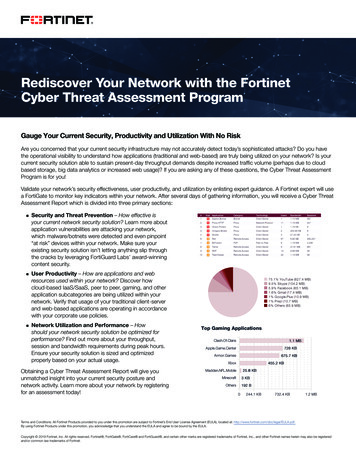
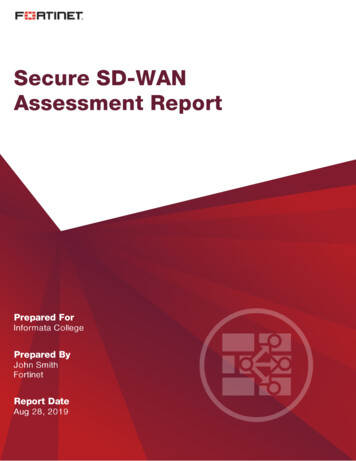
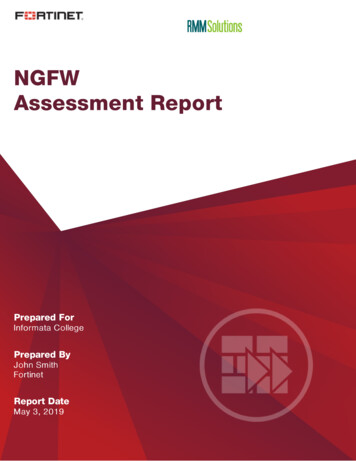

![INDEX [ actmindfully .au]](/img/14/2016-complete-worksheets-for-russ-harris-act-books.jpg)
![INDEX [thehappinesstrap ]](/img/14/complete-worksheets-2014.jpg)
